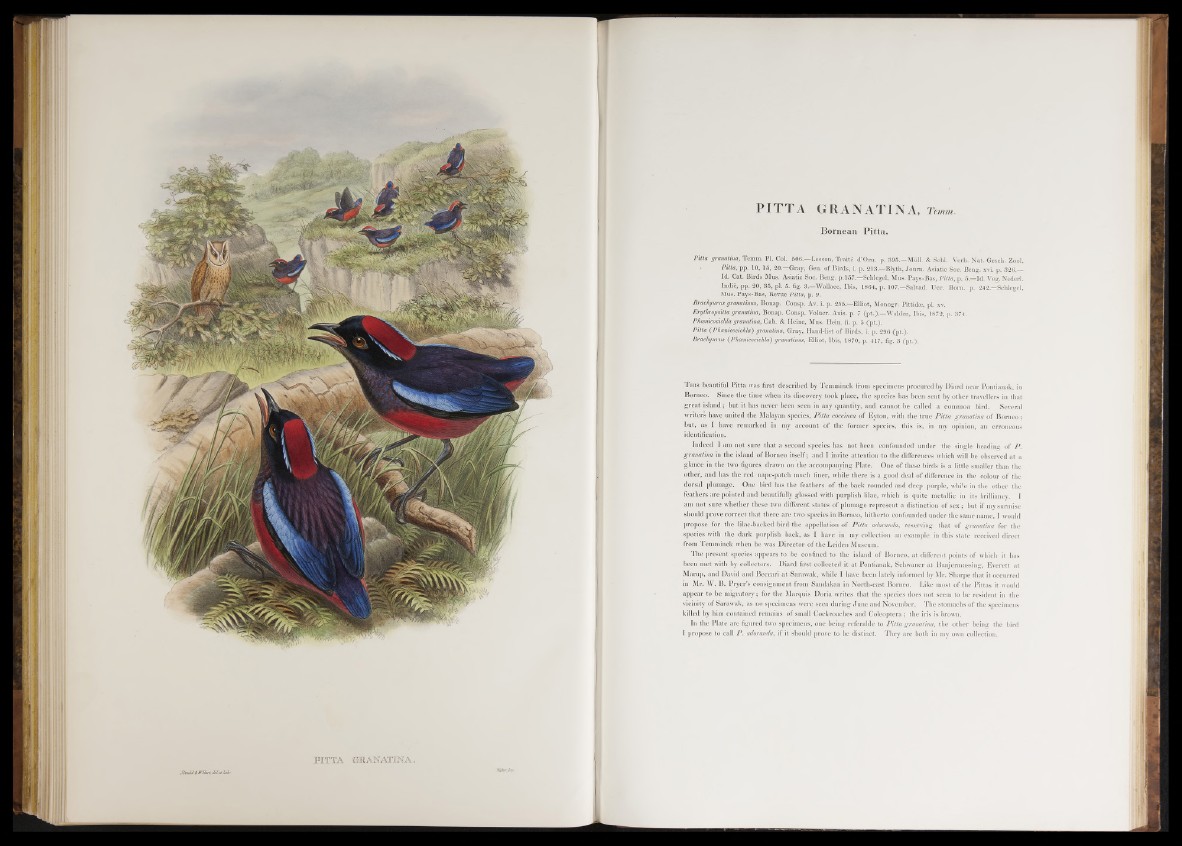
JGvald'tWBar&.deíet'Tiih/ Tñberjmp
PITTA GRANATIN A, Temm
Bornean P itta .
Pitta granatina, Temm. PI. Col. 506.—Lesson, T ra it! d’Om. p. 395.—Miill. & Selil. Verh. Nat. Gcsch. Zool.
Pitta, pp. 10, 15, 20. Gray, Gen. o f B irds, i. p. 213.—Blyth, Joum. Asiatic Soc. Beng. xvi. p. 326.—
Id. Gat. Birds Mus. Asiatic Soc. Beng. p. 157.—Schlegel, Mus. Pays-Bas, Pitta, p. 5.—Id. Vog.Nederl.
Indie, pp. 20, 35, pi. 5. fig. 3.—Wallace, Ibis, 1864, p. 107 Salvad. Ucc. Born. p. 2 4 2—Schlegel,
Mus. Pays-Bas, Revue Pitta, p. 9.
Brachyurus granalinus, Bonap. Consp. Av. i. p. 255.—Elliot, Monogr. Pittidse, pi. xv.
Erythropsitta granatina, Bonap. Consp. Volucr. Anis. p. 7 (p t.) .—Walden, Ibis, 1872, p. 374.
Phcenicocichla granatina, Cab. & Heine, Mus. Hein. ii. p. 5 (p t.).
Pitta (Phcenicocichla') granatina, Gray, Hand-list o f Birds, i. p. 296 (p t.).
Brachyurus (Phcenicocichla) granatinus, Elliot, Ibis, 1870, p. 417, fig. 3 (p t.).
T h is beautiful Pitta was first described by Temminck from specimens procured by Diard near Pontianak, in
Borneo. Since the time when its discovery took place, the species has been sent by other travellers in that
great island; but it has never been seen in any quantity, and cannot be called a common bird. Several
writers have united the Malayan species, Pitta coccínea of Eyton, with the true P itta granatina of Borneo;
hut, as I have remarked in my account of the former species, this is, in my opinion, an erroneous
identification.
Indeed I am not sure that a second species has not been confounded under the single heading o f P.
granatina in the island of Borneo itself; and I invite attention to the differences which will be observed at a
glance in the two figures drawn on the accompanying Plate. One of these birds is a little smaller than the
other, and has the red nape-patch much finer, while there is a good deal of difference in the colour of the
dorsal plumage. One bird has the feathers of the back rounded and deep purple, whi'e in the other the
feathers are pointed and beautifully glossed with purplish lilac, which is quite metallic in its brilliancy. I
am not sure whether these two different states of plumage represent a distinction of sex ; but if my surmise
should prove correct that there are two species in Borneo, hitherto confounded under the same name, I would
propose for the lilac-backed bird the appellation of Pitta adorando, reserving that of granatina for the
species with the dark purplish back, as I have in my collection an example in this state received direct
from Temminck when he was Director of the Leiden Museum.
The present species appears to be confined to the island of Borneo, at different points of which it has
been met with by collectors. Diard first collected it at Pontianak, Schwaner at Banjermassing, Everett at
Marup, and David and Beccari at Sarawak, while I have been lately informed by M r. Sharpe that it occurred
in Mr. W. B. Pryer’s consignment from Sandakan in North-east Borneo. Like most of the Pittas it would
appear to be migratory; for the Marquis Doria writes that the species does not seem to be resident in the
vicinity of Sarawak, as no specimens were seen during June and November. The stomachs of the specimens
killed by him contained remains of small Cockroaches and Coleóptera; the iris is brown.
In the Plate are figured two specimens, one being referable to P itta granatina, the other being the bird
I propose to call P . adorando, if it should prove to be distinct. They are both in my own collection.